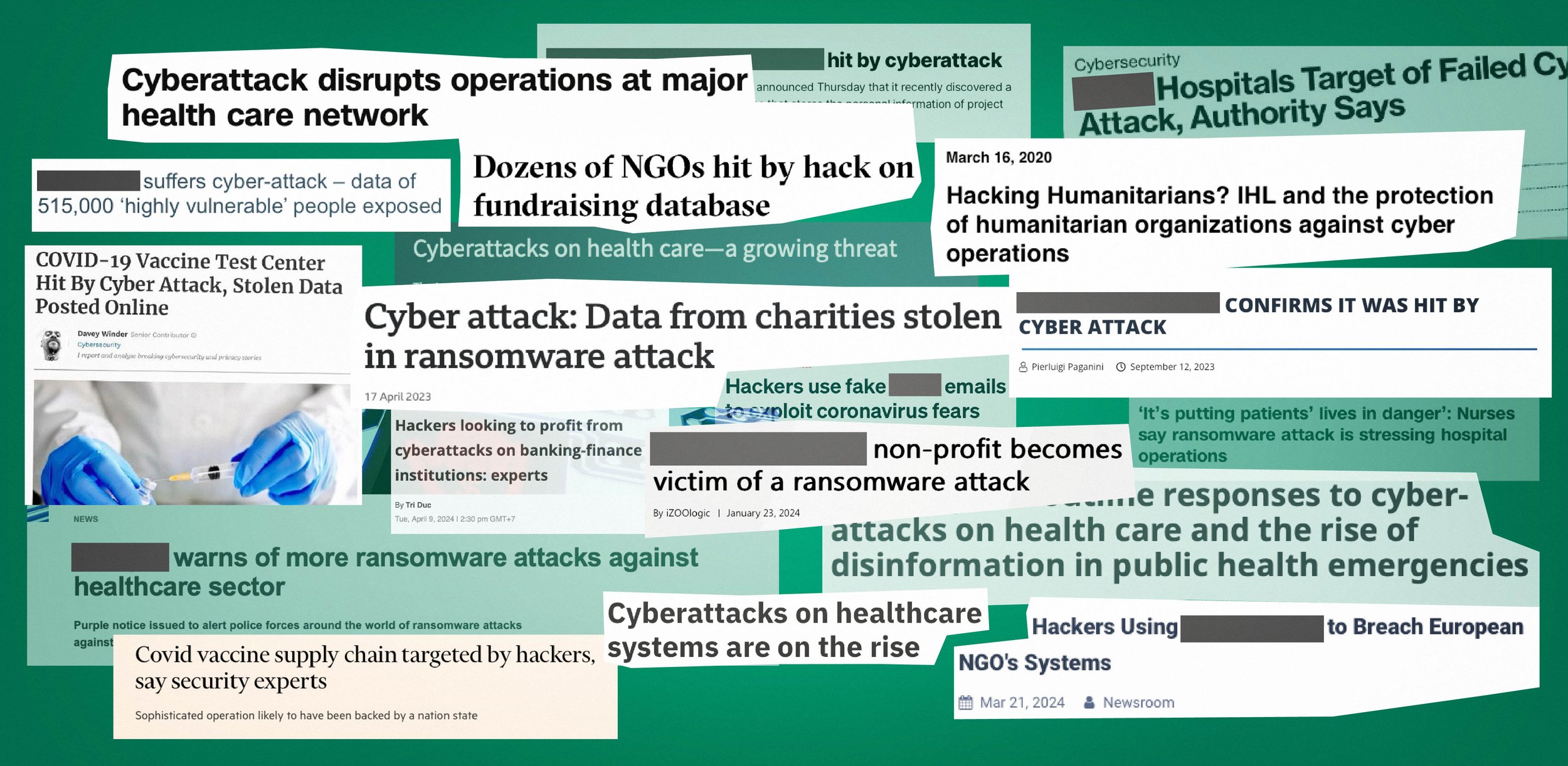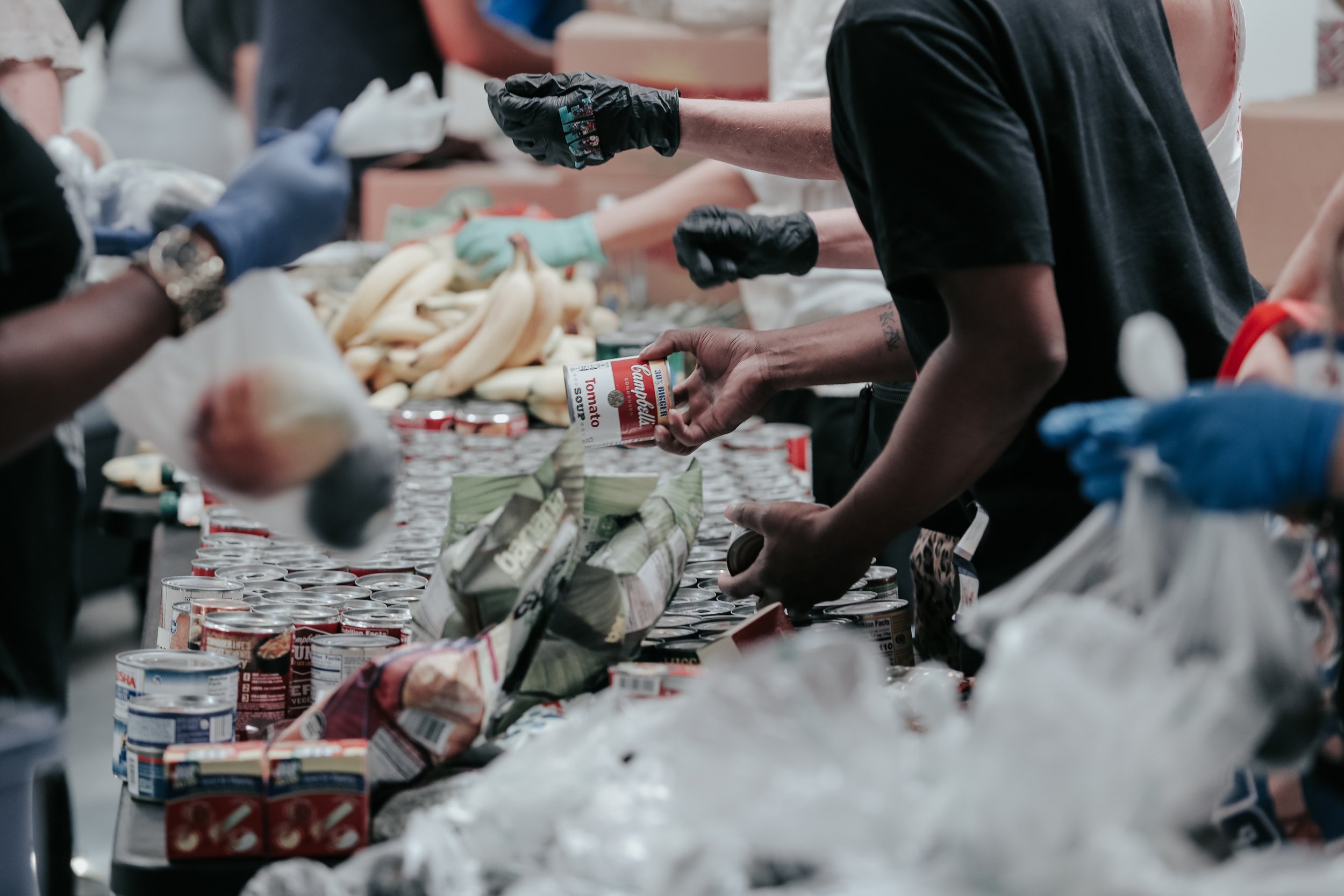
SURVIVORS
The stories of those under attack

-

Survivor - Humanitarian
“My colleagues got scared when confronted with this. The colleague who opened the email containing the malware started to feel guilty. We all did our best to reassure them. But there was this feeling of vulnerability, of being exposed.”
-

Survivor - Water & Sanitation
"I didn’t know what to do or who to turn to once we knew about the attack. How long had the breach been active? We had no idea of the extent of the hack.”
-

Survivor - Healthcare
“Nurses are running around. Doctors are running around. There’s no computers whatsoever they can use. This is a new reality we need to be better prepared for.”
-

Survivor - Mental Health
“It is difficult to understand why anyone would deliberately try to disrupt the work of an organisation that is relied on by people at their most vulnerable.”

ATTACK ON CLEAN WATER
A nonprofit organization focused on providing clean water across the APAC region suffered a significant cyberattack. The attack caused immediate disruptions to the organization’s operations, leading to delays in providing critical clean water services. Additionally, there are long-term concerns about the integrity of their data, potentially eroding donor trust and affecting future funding. This incident was a ransomware attack carried out by a cybercriminal group that operates a ransomware-as-a-service model. The attackers threatened to release sensitive information unless they were paid an extortion fee of $300,000.
Adapted from The Record, January 2024
-
Operational delay
Long-term data integrity issues
Impact to donor trust and funding
Loss of funds
-
SDG 6: Clean water and sanitation
SDG 16: Peace, Justice and strong institutions.

-
ATTACK ON COMMUNICATION
A nonprofit organization lost control of their Instagram account, a critical platform for their online presence. The loss of access to their Instagram account threatened to undermine the organization's credibility and disrupt their general activities. As their flagship online presence, the account's absence threatened to damage their reputation and hinder their ability to engage with supporters and the public. The incident began with a spear phishing attack via email, which appeared to come from Instagram. Two days after the attack, cybercriminals contacted the organization via WhatsApp, claiming responsibility and demanding a ransom to restore access. The attackers had altered the account’s email address, password, and phone number, ultimately disabling it.
Adapted from The CyberPeace Institute, December 2021
-
ATTACK ON PRIVACY
A prominent nonprofit organization, known for its global operations and significant revenues, fell victim to a cyberattack carried out by a ransomware gang. The attack resulted in the theft of more than 6.8TB of sensitive data, including 800GB of financial records, email communications, HR files, and personal data, which included medical and health information. The exposure of this data possibly impacted the nonprofit’s operations, endangered their privacy, and damaged its reputation, potentially affecting its ability to function across its 116-country network. The ransomware gang known for targeting critical infrastructure and healthcare organizations, claimed responsibility for the attack. Although the charity wasn’t directly named, a post on the gang’s dark web data leak site described the victim as "the world’s leading nonprofit" with US$2.8 billion in revenues.
Adapted from The Record, September 2023
-
ATTACK ON SUSTAINABILITY
A nonprofit organization focused on exchanging reusable items to reduce landfill waste suffered a significant data breach. The breach affected 7 million of the nonprofit's members, with sensitive information being sold on the dark web. The breach also reportedly included the data of the organization's executive director. The stolen data was available on the dark web for months, before discovered. The specific method used by the malicious actor to infiltrate the organization’s network remains unknown. Members have been cautioned not to interact with suspicious emails by clicking on links or downloading files.
Adapted from SecurityWeek, September 2023

ATTACK ON FOOD SUPPLY
A hunger relief organization based in the United States fell victim to a cyberattack that resulted in a significant financial loss. The organization was scammed out of more than $923,000, a substantial amount that could severely affect its ability to provide essential services. Beyond the financial hit, this incident threatened to undermine trust in the organization's operations, potentially impacting future support and donations. The attackers carried out a phishing campaign by intercepting legitimate emails from a construction company and sending a fraudulent invoice in its place. The organization unknowingly paid the fake invoice, falling prey to the scam.
Adapted from PhillyVoice, December 2020
-
Loss of funds
Loss of trust in organization
Impacting the delivery of essential services
Violation to the right of privacy
-
SDG 2: Zero hunger

-
ATTACK ON HEALTHCARE
An USA-based healthcare plan provider faced serious repercussions after a cyberattack compromised the sensitive data of millions. The breach exposed the protected health information of 3,180,537 individuals, including Social Security numbers and health records. The fallout from this exposure has resulted in multiple class action lawsuits, which could further damage the organization’s reputation and financial stability, potentially disrupting its ability to provide healthcare services. The attack was carried out by the Clop threat group, who exploited a zero-day vulnerability in the MOVEit Transfer file transfer solution. This vulnerability allowed the cybercriminals to access and steal the organization’s sensitive data.
Adapted from The Hippaa Journal, September 2023
-
ATTACK ON SAFETY
A Switzerland-based non-governmental organization, which provides conflict-related data to humanitarian groups, faced a disturbing cyberattack. Employees began receiving unsolicited pornographic material on their smartphones, causing distress and disruption. Additionally, the organization’s website was taken offline due to a denial-of-service (DoS) attack, hindering its ability to share critical data with humanitarian partners. The incident has shaken the organization's sense of security, as they previously believed their remote operations from neutral Switzerland offered them protection from such threats. Attackers launched phishing emails at the organization's employees, alongside the DoS attack. The organization's director described the incident as "a wake-up call," underscoring how their operations, despite being remote, are vulnerable to cyberattacks.
Adapted from The CyberPeace Institute, December 2022
-
ATTACK ON DONATIONS
A nonprofit organization responsible for blood donations experienced a serious data breach that exposed the personal health information (PHI) of over 550,000 individuals. The breach, caused by mishandled data, has led to a noticeable decline in blood donors. This not only threatens the lives of individuals who rely on these donations but also risks damaging the organization's ability to function effectively. The reputational damage and erosion of public trust could devastate donor relationships and jeopardize the organization’s future operations. The data leak occurred due to human error and poor data management. A contracted third party, responsible for developing and maintaining the organization’s website, left donor information unsecured on a development site. This oversight exposed sensitive donor data to the public.
Adapted from the OAIC, August 2017

ATTACK ON FAMILY REUNIFICATION
A Dutch healthcare NGO, involved in a family reunification program, was targeted by a cyberattack. The breach exposed the confidential information of 4,600 individuals in the Netherlands, linked to the organization's program focused on reuniting family members during times of conflict. As a result of the attack, the system had to be temporarily shut down, directly impacting those actively searching for missing family members. This disruption delayed crucial reunification efforts and affected the lives of vulnerable individuals. The cyberattack targeted a database containing sensitive information of 515,000 people. Although only a portion of the data was breached, the impact was felt by those connected to the family reunification program.
Adapted from Rode Kruis, January 2022
-
Violation to the right of privacy
Temporary shut down of humanitarian aid
-
SDG 16: Peace, Justice and Strong Institutions

-
ATTACK ON HUMANITARIAN AID
A nonprofit organization providing medical and humanitarian aid globally faced a security breach involving one of its servers based in Spain. The breach raised concerns about unauthorized access to the organization’s data, which could potentially compromise sensitive information. The extent of the information accessed remains unclear, but the incident highlights significant risks to the organization's data security and operational integrity. An advertisement surfaced offering access to the compromised server. A screenshot from the hacker indicated they had accessed a web panel for Citrix used by the Spanish branch of the nonprofit, which might have allowed them remote access to the organization’s data.
Adapted from Forbes, January 2022
-
ATTACK ON DONATIONS
A Dutch NGO focused on raising funds for humanitarian disasters was targeted by a cyberattack. The attack involved phishing emails sent to potential and current donors, misleading them into believing they were contributing to aid for Ukraine. Instead, the bank account listed in the phishing emails belonged to cybercriminals, not the NGO. This incident jeopardized donor funds and required the organization to implement additional cybersecurity measures to address the threat. The cyberattack utilized phishing emails to deceive donors, directing them to a fraudulent bank account. The NGO had to take extra steps to enhance its cybersecurity and mitigate the impact of the phishing campaign.
Adapted from Digital Trust Center, August 2023

What constitutes harm?
In recent years, cyberattacks and disinformation have increased significantly in frequency, scope, sophistication, and severity, and this trend is expected to continue, especially affecting vulnerable communities. It's important to understand that cyberattacks don't just damage technology—they can have lasting, often irreversible impacts on national and international levels. Cyberattacks and disinformation campaigns can have a full range of negative effects on victims' physical, psychological, social, and economic well-being. The alarming rise of disinformation from cyberattacks can contribute to an even greater level of harm, as disinformation is deliberately spread to deceive and undermine trust. Disinformation can break down confidence in organizations, governments, and societal institutions, exacerbating the broader damage of cyberattacks.
What is a cyberattack?
Cyber violence is defined by the CyberPeace Institute as any deliberate, negligent, or automated use of digital and information technologies that causes harm. This harm can be immediate, temporary, or long-term, and it impacts people’s health, physical and economic security, or the environment.
In other words, it includes attacks where a threat actor uses a computer network or system to disrupt, disable, destroy, control, manipulate, or monitor computing environments or data.
Privacy of the victims
To ensure the safety and privacy of the affected NGOs, we have omitted names, dates, and any private information in the creation of these stories. This approach is designed to prevent revictimization and protect the identities of those involved. Additionally, any images used in quotes and backgrounds were generated using AI and stock photos to further safeguard the privacy of the organizations. We are committed to respecting and protecting the confidentiality of NGOs to avoid any further harm.
Adapted from The CyberPeace Institute, December 2023
